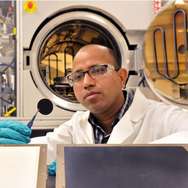Award-winning technology provides a breakthrough in particle physics

High-energy physics, it turns out, is a lot like life -- it's all about the timing.
In order to identify the tiny subatomic particles that erupt from the atom-smashing experiments that occur in subterranean laboratories like the Large Hadron Collider near Geneva, Switzerland, scientists need detectors that have split-second reflexes.
The desire to distinguish different particles has spurred a dramatic improvement in the process by which scientists and engineers at the U.S. Department of Energy’s (DOE) Argonne National Laboratory make large-area microchannel plates – key components in improving the time resolution in particle detection. The new discovery earned a 2012 R&D 100 award, which recognized researchers at Argonne and two partner institutions with one of the “Oscars of Innovation.”
Most of the challenge in particle detection comes from separating the signals emitted by the particles of interest from the background “noise” of other nearby collisions and events that happen almost simultaneously. Increasing the detector resolution in both temporal and spatial terms makes scientists more confident of their conclusions.
“Right now, most of our detectors have limits in the few hundred picosecond [one-trillionth of a second] range,” said Argonne physicist Robert Wagner. “If we could get down to the one picosecond range, we could get a much clearer picture of what’s happening as all these particles are zooming around.”
According to Wagner, the microchannel plate (MCP) detector is an electron amplifier, which essentially converts single electrons that hit a pore on one side of the plate into large bunches of electrons that erupt from the other side. “With precision timing, we can improve our localization of where a particle hits from a radius of a few centimeters to a few millimeters,” Wagner said.
While the basic technology behind microchannel detectors has existed for several decades, scientists have been looking for new ways to create larger and cheaper plates. “The major hurdle we face really is cost,” Wagner said.
Argonne’s industrial partner, Incom, developed an inexpensive method for producing large sheets of glass permeated with millions of microscopic pores. These “glass capillary arrays” have the necessary pore structure for an MCP, but lack the proper electrical properties. Fortunately, Argonne scientists lead by chemist Jeff Elam have developed a coating process to convert the glass capillary arrays into functioning MCPs. This technique, known as atomic layer deposition (ALD), deposits thin, electrically conducting films on the inside surfaces of the porous glass.
“By marrying ALD with glass capillary arrays,” said Elam, “we can fabricate microchannel plates of record size at a fraction of the cost.”
According to Wagner, this capability will have applications beyond the realm of high energy physics, including medical imaging and homeland security.
The development of the technology was supported by the High Energy Physics program within the DOE’s Office of Science. “Our efforts were not at all guaranteed to work out, and we're grateful for the support that DOE has consistently provided for this detector development project,” Wagner said.
The ALD work was initiated through a grant from DOE’s Advanced Manufacturing Office and facilitated by a Technology Maturation Grant through Argonne’s Technology Development and Commercialization Division.
Provided by Argonne National Laboratory





















